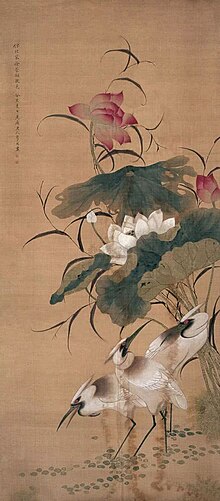Li Yin
Li Yin | |
|---|---|
 Lotus flowers and birds, by Li Yin | |
| Born | C. 1610 |
| Died | 1685 Haining, Zhejiang, Qing China |
| Nationality | Chinese |
| Known for | Painting, calligraphy, poetry |
| Spouse | Ge Zhengqi |
Li Yin (Chinese: 李因; C. 1610 – 1685), also known by her courtesy name Jinsheng (今生) and her art names Shi'an (是庵) and Kanshan Nüshi,[1] was a Chinese painter, poet, and calligrapher during the late Ming and early Qing dynasties, noted for her flowers and birds. Her artwork was sought after in her lifetime, resulting in as many as forty imitators in her area producing fakes of her works.[2]
Early life
Li Yin was born in Kuaiji (Shaoxing), Zhejiang, during the late Ming dynasty. Various sources give her year of birth as 1610, 1611, or 1616.[1] Her family background is not known but according to a contemporary biographical sketch her parents made her study poetry and painting from an early age.[2] Their financial circumstances were poor enough that she was said to have stored up liver mosses as paper and persimmon sticks to write with.[1] She likely made a living as a courtesan, as her contemporary biographer Huang Zongxi compares her to Wang Wei and Liu Rushi, two famous courtesans of the era.[3] She studied painting from the artists Chen Chun and Ye Danian (葉大年).[4]
Marriage with Ge Zhengqi
By the time she was a teen, Li's talent in both art and poetry was already recognized. The scholar-official and artist Ge Zhengqi, moved by a poem of hers, married her as a concubine.[1][5] They had a close relationship and spent much time together painting and composing calligraphy.[1]
During the reign of the Chongzhen Emperor, Ge served as an official in the imperial court in Beijing, where he and Li lived for more than ten years.[6] He travelled extensively for official business, and Li accompanied him to numerous places along the Yellow River and the Yangtze in their 15 years of marriage. She often composed poems about what she saw in her travels.[1]
Near the end of the Chongzhen reign, Ming China became increasingly unstable. In 1643, Ge and Li left Beijing for Nanjing, the country's southern capital. When they reached Suzhou, Anhui, they encountered a military rebellion.[6] Li, wounded in the chaos, stayed to search for her husband instead of fleeing the danger, and abandoned all her belongings except her poems. Ge was greatly moved by her loyalty and bravery. His disciple, Lu Chuan, later wrote prefaces to her poetry collections, in which he praises her as a loyal "minister" to Ge and compares her to the ancient beauty Xi Shi.[3]
Later life
After the fall of the Ming, the Manchu Qing dynasty invaded China and Ge died of suicide in 1645 when Nanjing fell.[6] Li Yin lived alone at the Laughing Bamboo Studio in Haichang, Ge's hometown in the suburb of Haining.[3] She lived for forty more years, supporting herself by selling her paintings.[2][7] The renowned scholar Huang Zongxi wrote her biography.[1]
Li was childless. On her 70th birthday, she composed a poem expressing her mixed feelings on not having children:[3]: 39
I have idled away seventy years of a floating life,
My true self has comprehended theravada.
Luckily I am spared from concerns for my children when I die.
Only cuckoos will cry on the ancient trees over my tomb.— Li Yin
Works

Over the course of her travels, Li Yin wrote 260 long and short poems that were published in two collections.[1]
Li Yin is noted for her paintings of flowers and birds, typically in ink monochrome with fluid brushstrokes. Her reputation was such that her paintings were considered an essential souvenir from Haichang and it is estimated there were forty imitators in the area turning out fakes of her works.[2] She painted with a flowing ink style reminiscent of Chen Chun (1483–1544), and was considered one of the finest women painters by critic Qin Zuyong.[1][2] Many of her paintings are in the collection of the Palace Museum, including:[1]
- Flowers and Birds
- Pine and Eagle
- Willows and Magpies
- Mynas and Pomegranates
- Lotus and Mandarin Ducks
- Flowers and Plants
Her other paintings include:[2]
- Flowers of the Four Seasons, 1649. Ink on satin.
- Yellow Hibiscus, date unknown, Ink on gold paper fan.
- Rock, Bird, and Pear Blossoms, 1654. Ink and colour on gold paper fan.
- Swallows and Peonies, 1673. Ink on satin hanging scroll.
References
- ^ a b c d e f g h i j Lee, Lily Xiao Hong; Lau, Clara; Stefanowska, A.D. (2015). Biographical Dictionary of Chinese Women: v. 1: The Qing Period, 1644-1911. Routledge. pp. 124–5. ISBN 978-1-317-47588-0.
- ^ a b c d e f Weidner, Marsha (1988). "catalogue". In Weidner, Marsha (ed.). Views from Jade Terrace : Chinese women artists, 1300–1912. Indianapolis Museum of Art. pp. 102–105. ISBN 0847810038.
- ^ a b c d Yang, Haihong (2017). Women's Poetry and Poetics in Late Imperial China: A Dialogic Engagement. Lexington Books. pp. 34–36. ISBN 978-1-4985-3787-2.
- ^ Sun Lisheng 孙黎生 (27 March 2018). "才女李因的水墨牡丹". Guangming Daily. Retrieved 16 October 2019.
{{cite web}}: CS1 maint: url-status (link) - ^ "Her Distinguished Brushwork: An Exhibition Featuring Paintings by the Seventeenth-Century Artist Li Yin". Chinese University of Hong Kong. 2017. Retrieved 18 November 2019.
{{cite web}}: CS1 maint: url-status (link) - ^ a b c Wu Lin 吴琳 (August 2013). "明清易代与才媛李因诗风之变". Journal of Suzhou College of Education (in Chinese). 30 (4): 40–42. ISSN 1008-7931.
- ^ Arcano, Katherine (12 May 2014). "The Artful Recluse: Painting, Poetry and Politics in 17th Century China". Artes Magazine. Retrieved 10 October 2019.
External links
 Media related to Li Yin at Wikimedia Commons
Media related to Li Yin at Wikimedia Commons
